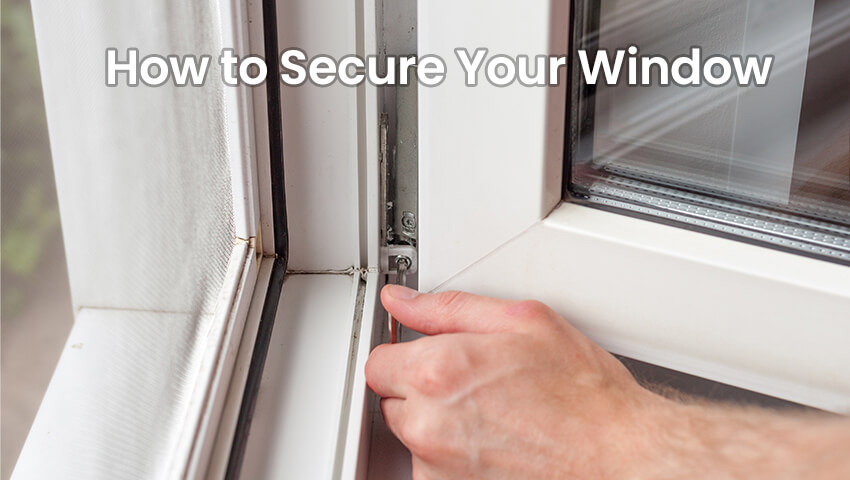Windows provide natural light and ventilation but are also one of the most common entry points for intruders. Studies show that nearly 30% of burglaries occur through windows, particularly on the ground floor or in areas shielded from street view. Securing windows requires a layered approach: combining physical reinforcements, smart technology, environmental adjustments, and household habits.
Contents
Assess Your Current Window Security
Before making upgrades, evaluate your current window situation:
• Window types: Sliding, casement, double-hung, or awning windows each have unique vulnerabilities. Sliding windows, for example, are easier to lift out of their tracks.
• Locks and latches: Check if your existing locks are sturdy or outdated. Weak locks are often a burglar’s first target.
• Glass integrity: Single-pane glass can be broken easily. Even double-pane windows may shatter under force if not reinforced.
• Frames and hinges: Look for rotting, warping, or loose frames and hinges, which make it easier for someone to force entry.
Document these vulnerabilities to determine the most effective security measures.
Window Security Measures
1. Upgrade Locks and Latches
Locks are the first line of defense for any window.
• High-quality keyed locks: Prevent forced entry. Ensure that keys are stored securely and not hidden outside.
• Multi-point locks: Engage multiple locking points along the window frame for stronger resistance.
• Secondary locks or pins: Especially useful for sliding windows to prevent them from being lifted out.
Extended Tip: Regularly inspect all locks for wear and tear. Lubricate moving parts to maintain smooth operation. Consider smart locks for windows that integrate with home security systems, enabling remote monitoring and control.
Example: A homeowner installed a multi-point lock on their sliding patio door. When an intruder tried to lift the window, the reinforced lock held firm, and a ZOSI camera nearby recorded the attempt, allowing authorities to respond promptly.
2. Reinforce Glass
Glass is often the easiest point of entry. Reinforcement can deter or delay intruders.
• Laminated glass: A tough, layered material that holds together even when broken.
• Tempered glass: Breaks into small, less dangerous pieces, making forced entry slower and more difficult.
• Security film: Applied to existing glass to prevent shards from scattering and delaying intrusion.
Extended Tip: Consider double-glazing for added insulation and security. Pair reinforced glass with window sensors to ensure that even if the glass is broken, alarms are triggered.
Example: A family reinforced their ground-floor living room windows with laminated glass and ZOSI sensors. Attempted break-ins failed, buying time for homeowners to respond.
3. Install Window Bars, Grilles, or Shutters
Physical barriers create a visible and effective deterrent.
• Fixed bars: Strong, permanent protection, ideal for ground-floor windows.
• Removable or collapsible bars: Provide protection while allowing emergency egress.
• Security shutters: Can block entry and visibility simultaneously, protecting both privacy and safety.
Extended Tip: When installing bars, ensure emergency exits are still accessible. Some designs combine strength with aesthetics, making them less intrusive.
Example: Homeowners with basement windows installed collapsible security bars. The bars prevented access while maintaining emergency escape routes, ensuring both safety and compliance with fire regulations.
4. Install Security Cameras
Cameras enhance both monitoring and deterrence.
• Position cameras near vulnerable windows, including ground-floor and side windows.
• Use AI-powered cameras: Motion detection, human recognition, and night vision improve reliability.
• Mobile integration: Receive instant alerts, remotely view footage, and respond even when away from home.
Extended Tip: For maximum effectiveness, angle cameras to cover approaches to windows and any nearby pathways. Regularly check camera settings and clean lenses for clear visibility.
Example: An outdoor WiFi camera with wide coverage can help you monitor your yard, entryways, and even windows without leaving blind spots. If your neighbor’s camera is already covering shared areas like the street, your system can balance that by focusing on your own property, such as windows where intruders might try to sneak in. Not only does this add protection, but it also gives you control over your side of the story.
5. Add Window Sensors and Alarms
Sensors and alarms provide proactive protection by detecting tampering and alerting homeowners.
• Contact sensors: Trigger alarms when windows are opened without authorization.
• Glass break detectors: Listen for the sound frequency of breaking glass.
• Motion detectors: Detect movement near windows and activate alarms.
Extended Tip: Integrate sensors with smart home apps to receive real-time alerts. Some systems allow you to trigger lights or cameras automatically when an alarm is activated.
Example: A ZOSI system with contact and glass break sensors alerted a homeowner when someone tried to open a window at night. The combination of alarm and camera footage stopped the intruder in their tracks.
6. Maintain Clear Visibility Around Windows
Environmental measures reduce the risk of undetected entry.
• Trim shrubs and trees to remove potential hiding spots.
• Use thorny plants near windows to create natural barriers.
• Install motion-activated lights to illuminate areas when movement is detected.
Extended Tip: Ensure pathways and windows are visible from the street or neighbor’s view. A clear line of sight deters burglars who prefer concealed approaches.
Example: A homeowner maintained landscaping and installed motion lights, which discouraged intruders from attempting access to ground-floor windows.
7. Use Curtains and Blinds Strategically
Curtains and blinds control visibility and simulate occupancy.
• Block views of valuables from outside.
• Use automated blinds or curtains to make it appear someone is home when away.
• Keep windows covered at night or when leaving for long periods.
Extended Tip: Combine window coverings with security cameras. Even if an intruder cannot see inside, cameras can still monitor their activity outside.
8. Educate Household Members
A secure home relies on consistent behavior.
• Teach family members to lock windows every time they leave or sleep.
• Establish a routine for checking all windows daily.
• Explain how alarms and cameras work, so everyone knows how to respond to alerts.
Extended Tip: Include guests or temporary residents in security awareness. Even small lapses, like leaving a window unlocked, can compromise safety.
9. Layer Multiple Security Measures
Layering increases the effectiveness of your security setup.
• Combine physical reinforcements, sensors, cameras, lighting, and behavioral habits.
• This approach ensures that if one measure fails, others provide protection.
Example: A family combined laminated glass, upgraded locks, window sensors, ZOSI cameras, and clear landscaping. This multi-layered strategy successfully deterred multiple attempted break-ins over time.
Tips for Different Window Types
Not all windows are created equal—each style comes with its own strengths and weak spots. A few simple measures can help you get the most protection out of them:
• Sliding Windows
These are common targets since they can be pried open. Use a security bar or a wooden dowel in the track to prevent forced entry.
• Casement Windows (Crank Style)
Keep the crank handles secure and consider locks that prevent them from being turned from the outside. Reinforced glass films can also add extra resistance.
• Double-Hung Windows
Burglars sometimes try to push these up from the bottom sash. Pin locks or sash locks can make them much harder to budge.
• Basement Windows
These are often hidden from street view, making them attractive to intruders. Reinforcing them with window well covers or metal grates adds a strong first line of defense.
• Bay or Picture Windows
Since they don’t usually open, focus on strengthening the glass itself. Security film or laminated glass can keep them from shattering easily.
FAQs
1. Which type of window is most vulnerable to break-ins?
Sliding windows are often considered the most vulnerable because they can be easily lifted off their tracks if not secured. Adding a security bar, pin, or track lock can greatly reduce this risk.
2. Do window security films really work?
Yes. Window security films make the glass harder to shatter, slowing down intruders and giving you more time to react. While not unbreakable, they act as an effective deterrent when combined with other security measures.
3. How can I secure second-story windows?
Even upper-floor windows can be targets. Use locks, reinforced glass, or security film. Also, ensure there are no nearby ladders, trees, or structures that could make it easy for intruders to climb up.
Conclusion
Windows are often overlooked when it comes to home security, yet they’re one of the most common entry points for intruders. By understanding the strengths and weaknesses of different window types, adding proper locks, reinforcing glass, and adopting simple habits like closing curtains at night, you can significantly reduce risks. A well-secured window not only protects your home from break-ins but also brings peace of mind every time you look outside.

